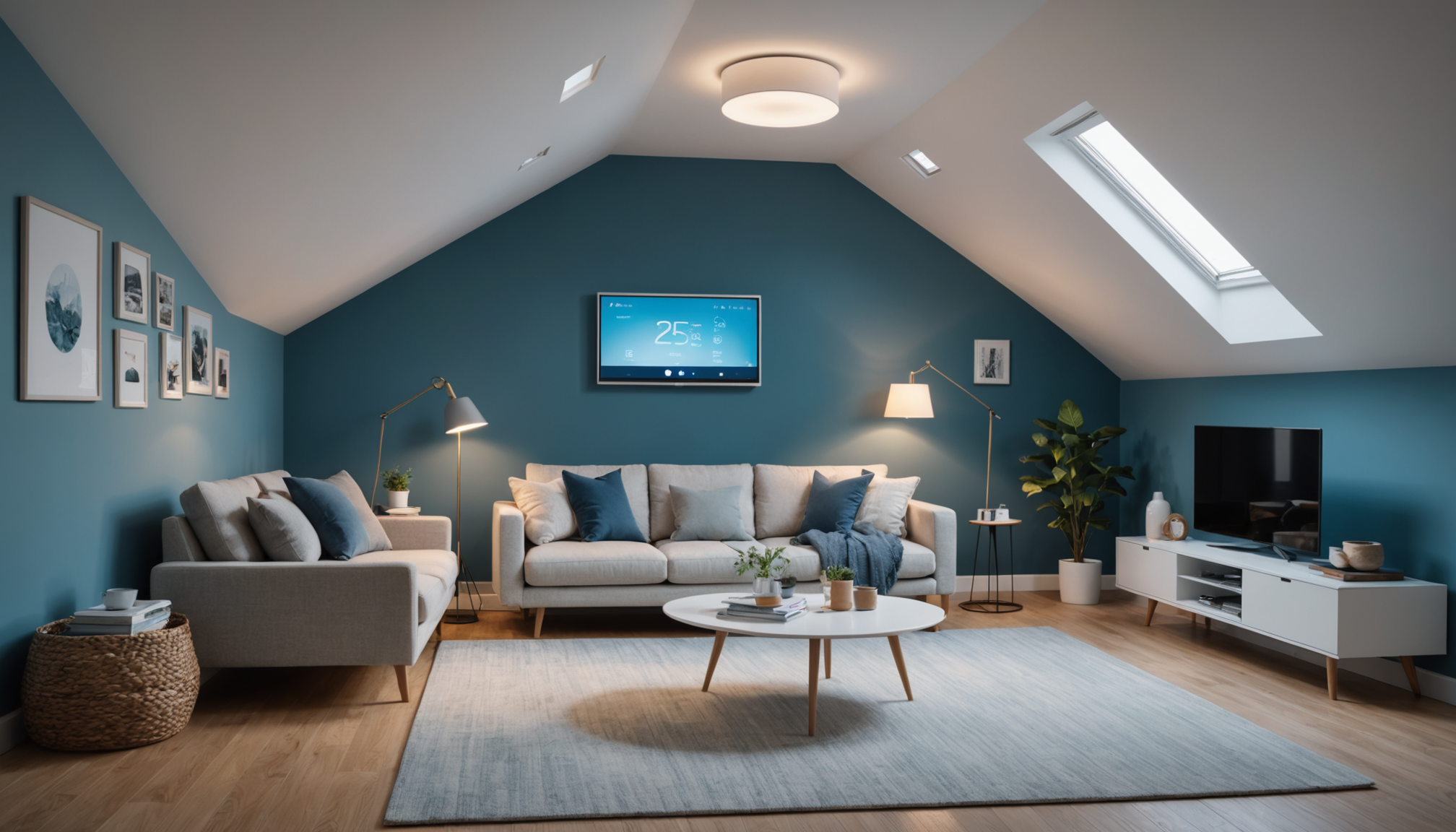Before embarking on the journey to automate your attic, it’s crucial to thoroughly assess the space to ensure it can accommodate the technological advancements you’re planning. A well-planned assessment will help in allocating your budget efficiently, ultimately protecting the investment you’re making into this renovation. The key is in analyzing the physical attributes of the attic, alongside understanding your family’s needs and aspirations for the space.
Begin by evaluating the structural integrity of your attic. This process involves checking for leaks, ensuring proper insulation, and confirming that the space can handle additional weights from any equipment or devices you plan to install. It’s also important to identify any pre-existing electrical wiring since this will aid in determining what modifications or upgrades will be required to support new smart technologies.
Next, take note of the attic’s dimensions and layout. Understanding the size and shape of the area will guide you in selecting the right devices and help you decide how best to position them for maximum effectiveness. Consider the ceiling height, available floor space, and access points when planning for automation installations. Smart lighting, for example, can dramatically transform the ambiance and utility of a cramped space, but choosing the right fixtures and placements hinges on these dimensional considerations.
- Passive vs. Active Use: Determine whether the attic is primarily for storage or if it’s expected to become a more actively used space, such as a home office or playroom. This will influence what types of automation systems are appropriate.
- Climate Considerations: An attic can be subject to extreme temperatures. Implementing climate control systems might be necessary to maintain comfort, which in turn would affect both the initial setup and ongoing energy consumption.
- Lighting Needs: Evaluate the natural lighting and decide if automated blinds or smart bulbs are required. Natural light can be a great asset, but the capacity to control lighting remotely adds a layer of convenience and efficiency that is hard to match.
Another crucial factor is connectivity. Smart automation relies heavily on stable and robust internet connections. Thus, during your assessment, check Wi-Fi signal strength throughout the attic. A weak signal could necessitate a mesh network or additional routers to ensure all devices function optimally.
Consider creating a table of potential issues and solutions to keep organized and focused:
| Potential Issue | Solution |
| Weak Wi-Fi Signal | Install a mesh network or range extender |
| Poor Insulation | Add or upgrade insulation materials |
| Lack of Electrical Outlets | Hire an electrician to install additional outlets |
This comprehensive assessment plays a fundamental role in the entire renovation process, allowing you to anticipate challenges and plan your attic automation project with precision. By methodically understanding your space and its limitations, you prepare the groundwork for a smooth transition to a fully automated attic environment that will accommodate the evolving needs of your family for years to come.
choosing the right technology
When selecting the right technology to automate your attic, it’s vital to identify devices and systems that align with your specific needs and the characteristics of your attic space. The aim is to create a seamlessly integrated environment that enhances utility, efficiency, and comfort. Begin by considering the core areas where technology can elevate your attic’s functionality, and then proceed to choose devices and systems that best fit those areas.
1. Smart Lighting Controls:
– Evaluate your lighting preferences and needs. Consider smart bulbs, switches, or fixtures to allow remote control and scheduling.
– Choose dimmable LED fixtures and color-adjustable bulbs to enhance ambiance while optimizing energy efficiency.
2. Climate Control Solutions:
– Install smart thermostats or sensors to maintain comfort levels and manage energy consumption effectively.
– Consider devices that support zoned heating and cooling, which can adapt to the attic’s specific climate conditions.
3. Security and Surveillance:
– Opt for smart security cameras or sensors for enhanced safety. These can be integrated into a broader home security system.
– Select devices with motion detection and real-time alerts to keep the attic secure even when you’re away.
4. Audio and Visual Entertainment:
– Integrate smart speakers or home theater systems if you plan to use the attic for leisure activities.
– Check compatibility with voice assistants or mobile apps for a more intuitive user experience.
5. Wi-Fi and Network Infrastructure:
– Since strong connectivity is crucial, consider advanced routers or mesh systems that can cover every corner of the attic effectively.
– Ensure compatibility with any smart devices you plan to install, as some may require specific network protocols.
6. Energy Management:
– Employ smart plugs and power strips to monitor energy usage and control devices remotely, leading to cost savings in the long run.
– Explore battery backup systems to safeguard against power outages, which might otherwise impact your automated systems.
7. Integration with Existing Systems:
– Assess compatibility with other smart home systems you might already own to ensure smooth integration and operation across your home.
– Look for cross-platform support, allowing you to control all devices from one central application.
By carefully selecting technology that aligns with the unique demands of your attic space and your family’s lifestyle, you not only enhance the utility of this area but also ensure that your investment in home renovation is maximized. Making informed choices at this stage involves considering both current needs and potential future upgrades, so the attic remains functional and adaptable as your family’s needs evolve.
installing smart devices
Once you’ve assessed your attic and chosen the right technology, the next critical step is skillfully installing those smart devices to effectively automate your attic. Proper installation is paramount to ensuring that each device not only functions individually but integrates seamlessly into a cohesive smart system.
Start with smart lighting, one of the most transformative aspects of attic automation. Installing dimmable LED fixtures and smart bulbs is a relatively straightforward process that can dramatically alter how the space is perceived and utilized. Smart switches should be installed by following the manufacturer’s instructions closely, ensuring that they are connected securely to your home’s Wi-Fi network. This connection allows for ease of adjustment from anywhere in the home and, crucially, even when you are away.
For climate control solutions, installing smart thermostats requires interfacing with your existing HVAC systems. If your attic has separate heating and cooling units, ensure that your chosen thermostat is compatible with these devices. Many smart thermostats come with easy-to-follow guides, but if you’re not confident in handling electrical systems, hiring a professional can be a worthwhile investment. This ensures efficient operation of your heating and cooling systems, which is vital given the extreme temperatures that attics often face.
When it comes to security and surveillance, strategically position cameras or motion sensors to cover entry points and any vulnerable spots in the attic. This layered security approach can safeguard your renovation investment and provide peace of mind for your family. Ensure that these devices have strong Wi-Fi connectivity and are capable of sending real-time alerts to your smartphone.
Installing audio and visual devices, such as smart speakers or home theater systems, should be done with acoustics in mind. The attic space can often create echo, so consider soundproofing measures or positioning speakers to minimize this effect. Integration with voice assistants can further enhance the user experience, allowing hands-free control of both entertainment systems and other connected devices within the attic.
Establishing a robust network infrastructure is a linchpin in any smart device installation. If you encounter dead zones during installation, consider additional access points or a repeater to ensure consistent connectivity throughout the attic. Devices like smart plugs and power strips should be installed at key locations to monitor and manage energy consumption effectively, leading to a more energy-efficient home environment.
The installation phase is also a time to ensure that all devices are compatible not only with each other but also with any existing systems in your home. This might involve setting up a central hub for easier control and monitoring of all smart devices. An integrated system allows for streamlined control of lighting, climate, and security features from a single interface, enhancing the overall functionality of your automated attic.
By meticulous planning and executing the installation of smart devices with precision, you lay the foundation for an efficient, adaptable automated attic that can serve your family’s needs for years to come. Whether it’s enhancing security, improving comfort, or optimizing energy use, installing these systems thoughtfully makes your attic a valuable asset in your larger home automation goals.
integrating automation systems
Integrating the various automation systems in your attic requires careful planning to ensure they work harmoniously, amplifying the utility and comfort of the space. To begin, you should focus on creating a cohesive network where all smart devices can communicate effectively. This means addressing any compatibility issues that might arise between different manufacturers and protocols. Many smart home devices operate on various platforms like Zigbee and Z-Wave, so choosing a universal smart hub that supports a wide array of devices is crucial. This hub acts as the brain of your attic’s automation, allowing you to control and monitor everything from lighting to climate control from a single interface.
A seamless integration relies heavily on robust wireless connectivity. Installing a mesh Wi-Fi system can eliminate dead zones, ensuring reliable coverage from the attic to the other parts of the house. Test the network strength after installation to guarantee that all smart devices, from surveillance cameras to smart thermostats, maintain stable connections. Reliable connectivity not only ensures smooth operation but also enhances the responsiveness of automated systems.
Consider adopting voice-assisted technology, such as Google Assistant or Amazon Alexa, to streamline the interaction with your attic’s smart systems. Voice commands offer a hands-free way to manage tasks, increasing convenience and accessibility for the entire family. By linking voice assistants with your smart hub, you make it easier to issue commands like “dim the lights” or “reduce the temperature,” simplifying the daily use of your attic space.
Energy management is another critical component of integrating automated systems. Utilizing smart plugs and power strips helps monitor energy consumption, providing insights into the efficiency of your new installations. Set up alerts or automatic shut-off routines for devices not in use, to prevent energy waste and lower utility bills. This approach not only supports a greener household but also prolongs the lifespan of your devices, aligning with your investment goals for this renovation.
Security integration further enhances the value of attic automation. Link your security systems with mobile apps to receive instant alerts and live feeds directly to your smartphone. Incorporating sensors at access points, or even setting up routines where the lights turn on automatically when motion is detected, adds an additional layer of security. This integrated approach ensures that the attic is as secure as it is functional, providing peace of mind and safeguarding your family’s investment.
Lastly, seamless integration should also extend to future adaptability. As your family’s needs evolve, so too might the demand for more advanced automation technologies. Design your system with scalability in mind, ensuring that it can accommodate new devices without significant reconfiguration. This proactive planning allows the attic to remain a flexible and valuable part of your home, adapting to changes in technology and family requirements.
By integrating these systems thoughtfully, you transform your attic into a versatile, efficient space that elevates the overall home automation experience. The effort and resources invested in this integration will provide enduring benefits, enhancing the value and utility of your home renovation project.
maintaining automated systems
Maintaining your automated attic systems is crucial for ensuring their longevity and continued performance, safeguarding the significant investment you’ve made in this renovation. Regular upkeep not only prevents potential issues but also maximizes the efficiency of your smart devices.
Begin by setting a routine for checking the health and performance of all installed devices. Frequent software updates are critical as they often include security patches and performance enhancements. Schedule these updates during times when the attic space is least used to minimize disruptions. Ensuring that your devices have the latest firmware will help keep your automation systems running smoothly.
Dust and dirt accumulation can affect device performance, especially for components like sensors and cameras. Conduct periodic cleaning, using microfiber cloths or gentle cleaning solutions to maintain optimal operation. Pay close attention to ventilation areas on devices such as thermostats and cameras, as dust buildup can lead to overheating or impaired functionality.
Monitoring energy consumption is essential in maintaining a balanced automation system. Use smart plugs to track energy usage and identify any unexpectedly high-energy devices. This information can inform adjustments to your usage patterns, ensuring that the attic remains energy efficient and cost-effective in the long term.
Connectivity is the backbone of any smart system, so regular network health checks are recommended. Check Wi-Fi signal strength and ensure that your mesh network or router firmware is up to date. Address any connectivity issues promptly, as a stable network is crucial for the seamless operation of all smart devices.
Security should also be a regular focus of maintenance efforts. Verify the functionality of alarms, motion detectors, and cameras by simulating various scenarios to ensure they respond as expected. Regularly change passwords and enable two-factor authentication where possible to enhance your security posture.
Additionally, maintaining a comprehensive log of all systems and their maintenance schedules can help in identifying patterns and proactively addressing potential issues. This log can be especially useful when diagnosing problems, as it provides a historical record of updates, cleanings, and check-ups.
Finally, remain open to upgrading systems as technology advances. The smart home industry evolves rapidly, offering new features and devices that can further enhance the functionality of your automated attic. Revisit your family’s needs periodically to assess whether new technology might improve your home’s automation.
In conclusion, automating your attic is a multifaceted process that extends beyond selecting devices and systems. It involves careful assessment of the space, strategic selection and installation of technology, seamless integration of systems, and ongoing maintenance. This deliberate approach not only enhances your attic’s utility and comfort but also ensures the longevity of your renovation investment, offering convenience and innovation that evolves with your family’s needs.


